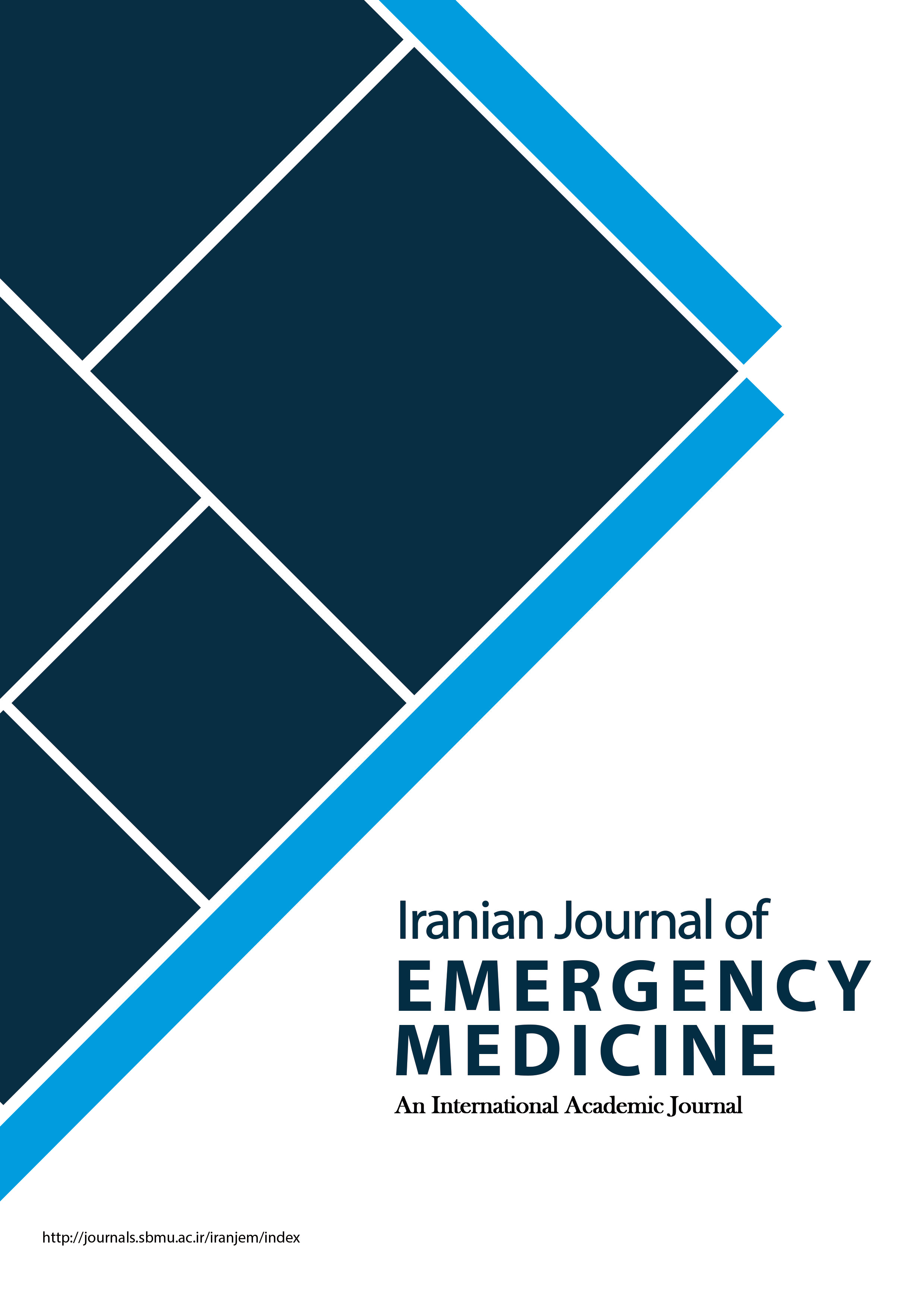Evaluating the Causes of Readmission to Emergency Departments of Hospitals Affiliated with Iran University of Medical Sciences
Iranian Journal of Emergency Medicine,
Vol. 6 No. 1 (2019),
23 February 2019
,
Page e13
https://doi.org/10.22037/ijem.v6i1.23347
Abstract
Introduction: Readmission is among the causes of overcrowding in hospital emergency departments. Identifying the characteristics of patients with readmission helps healthcare administrators propose more effective strategies to reduce the frequency of their readmission to the emergency department. This study was designed to investigate the characteristics of readmitted patients in emergency departments of hospitals affiliated with Iran University of Medical Sciences. Methods: Patients with more than 5 times admissions to emergency wards of Rasoul-e-Akram, 7 Tir martyrs, and Firoozgar Hospitals from March 2017 to March 2018 were selected using Health information system (HIS), which recorded computerized patient information. Frequency of referrals and patient complaints during readmission to emergency departments were extracted from patient records. Results: Out of all referrals to hospitals (around 20 thousand patients), 208 patients were readmitted to emergency departments of the mentioned hospitals more than five times (minimum 5 and maximum 10 times). Mean readmission frequency was 6.40 ± 1.26 times and mean patient age was 52.53±17.02 years. Most frequent underlying illnesses were cancer, asthma and chronic obstructive pulmonary disease (COPD), and heart ischemic; and the least frequent were schizophrenia, aplastic anemia, and drug addiction. Conclusion: There was a significant correlation between age and readmission (p-value=0.001). Cancer, COPD, and ischemic heart diseases were the most common causes of readmission to the emergency department. Shortness of breath, chest pain and weakness were the most common complaints at the time of readmission in this study.
- Patient readmission
- emergency medical services
How to Cite
References
Zuckerman S, Shen Y-C. Characteristics of occasional and frequent emergency department users: do insurance coverage and access to care matter? Medical care. 2004:176-82.
Chan BT, Ovens HJ. Frequent users of emergency departments. Do they also use family physicians' services? Canadian Family Physician. 2002;48(10):1654-60.
Doupe MB, Palatnick W, Day S, Chateau D, Soodeen R-A, Burchill C, et al. Frequent users of emergency departments: developing standard definitions and defining prominent risk factors. Annals of emergency medicine. 2012;60(1):24-32.
Hunt KA, Weber EJ, Showstack JA, Colby DC, Callaham ML. Characteristics of frequent users of emergency departments. Annals of emergency medicine. 2006;48(1):1-8.
Ledoux Y, Minner P. Occasional and frequent repeaters in a psychiatric emergency room. Social psychiatry and psychiatric epidemiology. 2006;41(2):115-21.
Byrne M, Murphy AW, Plunkett PK, McGee HM, Murray A, Bury G. Frequent attenders to an emergency department: a study of primary health care use, medical profile, and psychosocial characteristics. Annals of emergency medicine. 2003;41(3):309-18.
Henry MC. Overcrowding in America's emergency departments: inpatient wards replace emergency care. Academic Emergency Medicine. 2001;8(2):188-9.
Derlet RW. Overcrowding in the emergency department. J Emerg Med. 1992;10:93-4.
Derlet RW, Richards JR. Emergency department overcrowding in florida, new york, and texas. Southern medical journal. 2002;95(8):846-50.
Shih F-Y, Huel-Ming M, Chen S-C, Wang H-P, Fang C-C, Shyu R-S, et al. ED overcrowding in Taiwan: facts and strategies. The American journal of emergency medicine. 1999;17(2):198-202.
vila J. Interview: Emergency Room Overcrowding. NBC, January. 2001;9.
Jain S, Cheng J. Emergency department visits and rehospitalizations in late preterm infants. Clinics in perinatology. 2006;33(4):935-45.
Gordon JA, Billings J, Asplin BR, Rhodes KV. Safety net research in emergency medicine proceedings of the academic emergency medicine consensus conference on “The Unraveling Safety Net”. Academic Emergency Medicine. 2001;8(11):1024-9.
Ruger JP, Richter CJ, Spitznagel EL, Lewis LM. Analysis of costs, length of stay, and utilization of emergency department services by frequent users: implications for health policy. Academic Emergency Medicine. 2004;11(12):1311-7.
Fuda KK, Immekus R. Frequent users of Massachusetts emergency departments: a statewide analysis. Annals of emergency medicine. 2006;48(1):16. e1-. e8.
Locker TE, Baston S, Mason SM, Nicholl J. Defining frequent use of an urban emergency department. Emergency Medicine Journal. 2007;24(6):398-401.
Trzeciak S, Rivers EP. Emergency department overcrowding in the United States: an emerging threat to patient safety and public health. Emergency medicine journal. 2003;20(5):402-5.
Derlet RW, Richards JR. Overcrowding in the nation’s emergency departments: complex causes and disturbing effects. Annals of emergency medicine. 2000;35(1):63-8.
Schull MJ, Szalai JP, Schwartz B, Redelmeier DA. Emergency department overcrowding following systematic hospital restructuring trends at twenty hospitals over ten years. Academic Emergency Medicine. 2001;8(11):1037-43.
Pines JM, Asplin BR, Kaji AH, Lowe RA, Magid DJ, Raven M, et al. Frequent users of emergency department services: gaps in knowledge and a proposed research agenda. Academic Emergency Medicine. 2011;18(6):e64-e9.
- Abstract Viewed: 571 times
- PDF (فارسی) Downloaded: 168 times
- HTML (فارسی) Downloaded: 48 times



